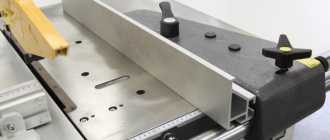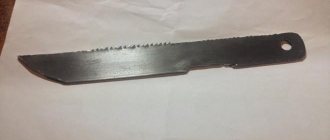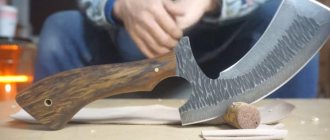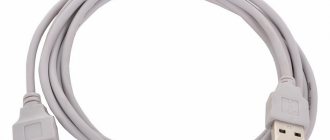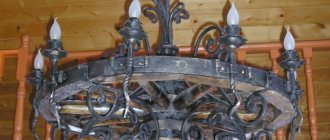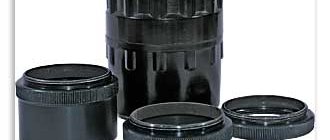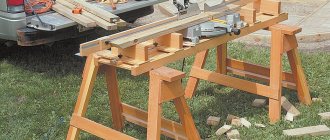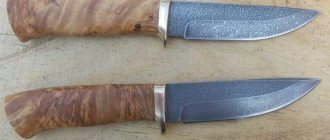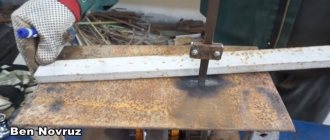An apartment kitchen, a fishing camp, a hunting lodge - in these places, as in many others, knives are required. Working with any knife only brings joy and satisfaction when the knife is sharp. An incorrectly sharpened knife is no different from a dull one, so below we will talk about how to create a machine for sharpening knives with your own hands without the use of complex technologies and expensive materials.
Rules
Often, when sharpening knives at home, household members use abrasive whetstones. However, in order to use them in practice, you need the necessary skills and experience working with them. After all, if the knife is sharpened at the wrong angle, the blade remains dull.
Layout of the block to the blade.
Before actually manufacturing the machine, you need to listen to the advice of sharpeners.
When sharpening a knife, the master performs the following actions:
Defines the angle between the working area of the blade and the block. Moreover, for each model the angles are different;
The knife is located at an angle of 90 degrees to the direction of the block. The grooves that are formed when the razor blade of the knife rubs against the block should be at 90 degrees to the knife line. The angle in such a situation is equal to half the sharpening;
Typically the angle is 25 degrees;
The mechanic begins processing from the beginning of the foot blade;
When adjusting the sharpening angle, the master paints over part of the foot blade with any marker. As a result, the mechanic directly controls the work area.
As a rule, after sharpening the working blade has non-uniform deformations. Therefore, when processing independently, the “point of reference” should not be the sharp part of the knife.
Choosing whetstones for sharpening a knife
The main indicator of a block is its grain size.
The whetstone is the main component that makes the blade thin and sharp. As a result, before choosing a design, you need to select the necessary blocks.
When sharpening knives on their own, household members use these types of whetstones
which have a high grain size. Using such bars, the shape of the leg blade is corrected.
having medium grain size. With the help of such bars, the mechanic removes the grooves that are formed during the initial processing of the knife
whetstone, which is covered with GOM paste. In such a situation, the mechanic polishes the blade.
When processing knives for the kitchen, you can use two types - with medium and high grain. And also in this case it is necessary to use a touchstone.
Necessary conditions for a sharpening machine
In order to make a knife sharpening machine with your own hands, you need to carefully plan the stages of work and draw up drawings. If the master has experience, then he can develop them himself or use ready-made drawings that are offered in specialized literature.
For ideal processing of the cutting surface, the machine must meet the following requirements:
- reliable and at the same time not too rigid fixation of the knife in a vice;
- compliance with the angle, during the sharpening process the angle must be constant;
- The design of the machine must provide for the possibility of changing the sharpening angle.
You can read below about how to make your own blade straightening devices that are in no way inferior to purchased mechanisms.
DIY knife sharpener
Base
When making a sharpening machine at home, you can use various parts. In particular, you can use laminated box plywood 12 mm thick, which was previously used to create radio equipment housings.
When constructing a machine at home, a household member performs the following actions:
Selects a base for such an installation, which must weigh at least 5 kg. Otherwise, it will be impossible to sharpen chopping devices and tools on the machine. Therefore, in the manufacture of such equipment, the tenant uses various steel angles measuring 20x20 mm;
Next, 2 parts are cut out of plywood with a jigsaw, which have a trapezoidal shape, the base is 170 by 60 mm, and the height is 230 mm. When cutting, the mechanic makes an allowance of 0.7 mm for sharpening the ends: they end up straight and fit according to the markings;
Installs 3 parts between the inclined walls on the sides - an inclined surface made of plywood with dimensions of 230 x 150 mm.
In such a situation, the trapezoidal sides are located laterally on a rectangular surface.
The result is a base - a wedge. In such a situation, a protrusion of an inclined surface measuring 40 mm is formed in the front part;
Then, along the side wall ends, the mechanic marks 2 lines with a thicknesser. At the same time, it retreats by half the thickness of the plywood;
Next, he drills 3 holes in the boards to connect the parts of the structure with screws;
Drills the ends of the inclined surface and connects the base parts for a while;
At the back of the structure, the mechanic connects the side walls using a 60x60 mm block, which is attached to the end with two screws on both sides; — makes a 10 mm gap in the block.
In such a situation, it retreats 50 mm from the center - 25 mm from the edge. To maintain a vertical position, first drill with a thin drill from 2 edges, and then expand;
Then, at the top and bottom, two threaded fittings are screwed into the gap, and in the fittings - a 10 mm pin, the length of which is 250 mm.
If the threads do not match the studs, the lower fitting is adjusted.
Why do knives get dull?
In some homes, knives remain sharp for a long time, and there is no need for sharpening. And for some owners, on the contrary, they become dull every now and then. Why is this happening? Here are the most common reasons:
- Use ceramic and durable glass cutting boards. These boards are, of course, beautiful, but they do not perform their main function well, and the blades quickly become dull;
- Improper storage. They usually become dull due to corrosion. Corrosion, or rust, occurs if the main kitchen tool is stored in conditions of high humidity;
- Any knife gradually becomes dull as you work. Small particles of food (vegetables, fruits, meat and fish) inevitably fall on the working surface of the blade, and the sharpness of the blade gradually decreases;
- The cutting tool will lose its working properties very quickly if you cut all types of products with one knife. It is not worth doing this for sanitary and hygienic reasons.
Tool support device
When making a handhold device, the following steps are performed:
Removes the flat inclined part from the base, modifies it and installs a fixation device on it, as well as the clamp of the device used;
Measures 40 mm from the edge in front and, using a garden hacksaw, uses this mark to cut out a groove, the depth of which is 2 mm;
Using a shoemaker's knife, chip off the top 2 veneer layers from the end of the board. The result is a sample into which the mechanic inserts a 2 mm steel plate at the same level as the general surface;
The tool rest consists of 2 steel strips measuring 170x60 mm and 150x40 mm. The machine operator connects them along the large end, which has equal edge indentations, and makes 3 through slots of 6 mm.
Using bolts, tighten the planks along the cracks made. In such a situation, the machine operator leaves the bolt heads on the side of the large top plate;
Next, using electric arc welding, the bolt heads are baked and welded to the plate;
Then he removes metal defects of the weld in the form of beads and grinds the plate to give it a smooth surface;
Applies a small striker plate to the edge recess, moves the slots with a drill and secures the support with bolts.
Manual sharpener with adjustable stone
This machine is a more complex design, but it is much more convenient to use. The basis for its creation was a model of a machine called the Lansky sharpener.
Lansky sharpener
The advantage of such models is the reliable fixation of the knife blade.
The device is a support table on which the knife is fixed. At the opposite end of the table, a screw stand with a bar is vertically fixed. A guide rod is inserted into this bar, on which an abrasive stone is mounted. By moving the bar along the screw rod, you can change the angle of metal processing.
The advantages of machines with a similar design include:
- high processing accuracy;
- the possibility of replacing the block with sandpaper glued to plexiglass;
- The wide support base allows you to secure the machine with clamps on any table.
When operating the machine, the only difficulty lies in the long-term adjustment of the position of the sharpening stone. If you plan to process different types of blades, you will have to reconfigure the device each time.
Fixation device
The second important part of the tool rest is the clamping bar. It can be made from 2 parts.
L-shaped plank measuring 150x180 mm, the width of the shelves is 50 mm (top);
A rectangle-shaped strike plate measuring 50x100 mm (bottom).
When making a clamping bar, the machine operator performs the following actions:
Places the bottom bar on the far edge of the top bar;
Makes 2 holes in the center and retreats 25 mm from the edges of the part, connects the parts through the holes with two 8 mm bolts;
Screws in 8 mm bolts on 2 sides. In such a situation, the head of the nearest bolt is located near the top bar;
Welds the bolt heads to the plates and grinds them in advance until roundness is formed;
Yes, the inclined board retreats 40 mm from the edge and draws a line with a thicknesser;
Makes one 8 mm 25 mm gap at the bottom and top edges;
Using markings, he connects the edges of the slots and uses a jigsaw to make a cut with an allowance. Use a file to expand the groove to a width of 8.5 mm;
It fastens the planks using a groove that is in the board; the top bolt is tightened with a nut and thus firmly fastens the plank.
Then tightens connection 2 with nut;
When pressing the bottom bar (in the niche of the base), screw a wing nut onto the second bolt.
How to sharpen a disc by hand with a file
If an emery machine is not available, the procedure can be performed manually. The principle of sharpening is that the disc being sharpened should be fixed in a stationary position. A vice or clamp is used for this. When the equipment is fixed, all that remains is to pick up a marker and mark the starting point of the work. Next, sharpening work is carried out using a file.
- It is recommended to use a flat file, but a triangular file will also work. The main requirement for a file is that it fits freely between the teeth.
- There is a lot of wear on the front and top of the tooth, so this wear should be restored
- At the initial stage, the back surface of the teeth is restored, and then the front
- When sharpening, you need to apply the same force. In addition, the size of the teeth, or rather their size, must be the same
Carrying out sharpening work by hand is much more difficult and takes longer, so this method is rational only in one case, if you do not have to work with a circular saw often. If work with a tool is carried out frequently, then it is rational to buy an emery machine and make equipment from it for sharpening circular saw blades.
Sharpening angle control
When adjusting the sharpening angle, the mechanic performs the following actions:
Throw a large washer onto the pin, which is located in the block of the machine base, and tighten the nut.
The rod does not rotate in the foot; the block for adjusting the sharpening angle is made from a small carbolite block, the dimensions of which are 20x40x80 mm.
15 mm from the block edge, drill a 20 mm end on both sides, widen the gap to 9 mm, then make a thread inside;
He steps back 50 mm from the axis of the new slot and drills another one in the flat part of the workpiece - 90 degrees to the previous one. Such a slot has a diameter of 14 mm. In such a situation, the mechanic strongly flares the hole using a round rasp;
Screws the block onto the stud - sets the desired height of the eye without using fixing screws;
Secures the block on both sides with M10 hex nuts.
Differences in insert teeth
The tooth of hard alloys has four main planes for work: front, back and lateral (auxiliary). When the planes intersect with each other, cutting edges are formed: the main one and a pair of auxiliary ones.
The shape of the teeth is as follows:
- Direct. The use of this form will be justified when longitudinal cutting is required, which is quick in time and not required in quality.
– Oblique or beveled. The angle of inclination of the rear shape can be right or left, they alternate with each other. This configuration is the most common. Sharpening blades of different sizes are used to work with different materials in any direction.
– Trapezoidal. This tooth dulls its edges more slowly than a beveled tooth. Alternate it with the straight one. In this case, the rough cut was a longer trapezoidal cut, and the finishing cut was a short straight cut.
– Conical. This form of teeth performs a rough cut on the lower edge of the boards, while protecting the upper edge from chipping. Basically, the front edge of such an element is flat. But if you make it concave, then it is possible to use this device for cross cutting in a finishing version.
Read also: How to use a forstner drill
Using replaceable blocks and making a carriage
When making a sharpening carriage, the machine operator performs the following actions:
Welds 30 cm M10 threaded rods with a smooth rod whose thickness is 10 mm;
Uses 2 solid bars 50x80 mm and the thickness is 20 mm. In all blocks, in the center and on top, 20 mm is retreated from the edge, and then a gap is made 10 mm wide;
Screws a wing nut onto the rod, then a large washer and 2 bars, then a nut and washer;
Clamps rectangular sharpening stones between the stones or makes several replaceable sharpening stones.
As a timber base, the machine operator uses a rectangular tube from a profile or a piece of cornice, the width of which is 50 mm;
He sands the flat machine part and cleans it of grease, and glues strips of sandpaper with a grain size of up to 1200 grit using Super Moment glue.
The sandpaper should have a fabric base, and on one of the blocks you need to glue a strip of suede to apply polish to the blades.
How to sharpen a blade on a circular saw with pobedit tips
Craftsmen often buy wheels that have increased wear resistance due to the presence of special pobedite soldering. These soldering extends the service life of the consumable, but does not make it last forever. The pobedite layer is applied to the links using a special solder. Due to soldering, the geometric shape of the tooth becomes more complicated, and therefore the sharpening process also becomes more difficult. Restoring the sharpness of the teeth must be carried out taking into account precise exposure.
To sharpen the teeth on a carbide-tipped blade, you will need to smooth the cutting edge to 0.3 mm. To perform high-quality sharpening of carbide-tipped teeth, experts recommend using special equipment for this, as well as diamond-coated grinding wheels. If you use an abrasive wheel, it will quickly wear off before the soldered disc can be sharpened.
When restoring the sharpness of links, the following factors are taken into account:
- Saw blades must be sharpened not only on the front, but also on the rear plane. You need to start directly from the front
- When sharpening, the pobedit tip should be in close contact with the diamond sharpening wheel.
- The contact time should be no more than 5 seconds. It is necessary to take into account the time in order to avoid overheating of the metal. If the metal overheats, it will harden and decrease in hardness.
When sharpening, you must also take into account that the thickness of the material being ground should not be more than 0.15 mm. If the procedure is carried out correctly, then at least 30 sharpenings are carried out until the disk with pobedit tips is completely worn out.
This is interesting!
When sharpening discs, you need to take into account that the teeth can have a negative and positive angle.
If a tooth has a negative angle, it is more difficult to sharpen it at home than a positive one. You need to make your own decision about the rationality of restoring the sharpness of tipped discs, since the cost of a diamond-coated grinding wheel is sometimes more expensive than electrical drive equipment.
Emery from a washing machine motor
What's good about Soviet washing machines is that they were equipped with reliable electric motors
Another advantage of using such motors for a sharpener is the low power and shaft speed, and this is important for an emery grinding wheel, which at high speeds can simply crack upon contact with the tool being processed. Good weight and power supply from a 220 V network are also convenient: in the first case, the emery will be stable without the use of additional attachments, the second indicator saves the master from the need to assemble the starting unit for the emery: it can simply be taken from the washing machine
Sandpaper from a washing machine engine is in no way inferior to factory models. And if in the case of Chinese technology one can still doubt the longevity of the product, then a homemade design, where every detail has passed through its own hands, will indeed be an indispensable assistant for many years.
What you need
To make emery with your own hands, you will need certain tools and materials. The simplest design eliminates the need for welding and turning, which allows it to be manufactured by almost anyone. Set of necessary tools:
- a jigsaw or a regular wood hacksaw (it’s better if the hacksaw is a packaging one);
- electric drill with a set of drills;
- screwdriver or shaped screwdriver;
- Angle Grinder;
- soldering iron 100 W;
- small chisel;
- a square with one of the angles at 90 degrees;
- calipers;
- drawing compass;
- drawing pencil and tape measure;
- metal scissors;
- bench vise;
- a piece of 150 grit sandpaper.
Set of necessary materials and equipment:
- model of a Soviet electric motor from a washing machine with capacitors;
- toggle switch for loads up to 1.0 kW;
- cord with socket 2 meters long;
- small sharpening stone with a mounting hole diameter of 32 mm;
- chipboard slab measuring 0.5x0.5 meters and thickness 0.02 meters;
- multilayer plywood measuring 0.15x0.15 meters and thickness 0.01 meters;
- timber measuring 60x60 mm and height 0.2 meters;
- wood screws 50 and 20 mm with a press washer;
- galvanized sheet 0.5x0.5 meters in size and 1 mm thick;
- rubber stoppers for antibiotics in the amount of 4 pcs.
Which engine to choose
As mentioned above, the parameters of the washing machine motor must meet certain criteria. Taking the first engine you come across and building an emery structure around it is not very practical if in the end it turns out that it will be impossible to work on such a machine. Therefore, craftsmen with practical experience recommend proceeding from the following points when choosing an engine for making emery with your own hands:
- the most common models among Soviet engines that are used to make emery are the motors of such washing machines as “Malyutka”, “Sibir”, “Volga” or “Vyatka”;
- the recommended engine shaft rotation limit is 1500 rpm;
- It is advisable to take the power no lower than 100 Watts and no higher than 1000 Watts, the most famous motors have a power within 400 Watts;
- if the engine has support legs with holes for fasteners, this is welcome;
- The engine of the future emery must be designed for a voltage of 220 Volts.
When removing the engine from the washing machine, it is important to remove the entire starting circuit along with it, so as not to separately select and buy capacitors for the emery. If the engine does not have support legs, this will not prevent it from being installed in the structure
It is important here that it has studs, by means of which the body of the unit is tightened: by attaching it to these studs, the motor will be installed on the emery.
How and from what to make security elements
The protective casing in the emery is an extremely important design element. It serves as a protection against possible injuries when the grindstone breaks, and also prevents sparks from getting into the eyes and onto nearby objects. Also, if you take motors from washing machines, then in some of them the stator winding may be open and it must be protected from abrasive and other foreign particles. It is impossible to seal the engine housing, as this disrupts the cooling mode of the unit and it may fail. In this case, the protective casing also plays an important role, simultaneously protecting the emery motor.
The most convenient way to make a protective casing with your own hands is to make it from galvanized steel. It is not necessary to make it round, following the contours of the working grinding wheel; it is easier to make it in the form of a truncated cone, where the upper part is slightly larger in size than the diameter of the stone. The easiest way to attach such a casing is not to the engine, but directly to the emery support on which the motor is mounted.
